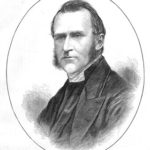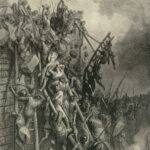One of the most frustrating aspects for the followers1 of Jacob Arminius’ teachings on God’s nature, character, salvation — including grace, election unto salvation, justification and conditional perseverance with an accompanying final or ultimate salvation — is the fact that, subsequent to the death of Arminius in 1609, the legacy of Arminius’ theology is noted but not entirely embraced or consistently propagated by the Remonstrants — the early Arminians who remonstrate (i.e., protest, object to, and challenge) the Calvinism of their era. Without doubt, the Arminian Confession of 1621, penned by Arminius’ brilliant successor Simon Episcopius, expounds upon the theology and soteriology of Arminius, in catechetical form. But even Episcopius differs from Arminius on the issue of original sin. This doctrine is significant for Arminius.
Hugo Grotius, too, deviates from Arminius’ Reformed views on the atonement in lieu of his novel Moral Government theory. Some years later we find further deviation from Arminius in the person of Philipp van Limborch, Remonstrant theologian and professor at the Remonstrant Seminary in Amsterdam, and also personal friend to Enlightenment philosopher John Locke. W. Stephen Gunter comments that, from the beginning of the Remonstrance of 1610, we “begin to lose sight of Arminius himself, as well as certain important aspects of his theology.”2 This is not to confess that Arminius’ theology is a novel invention that fails to capture the minds and hearts of its supposed adherents. After all, the theology of Arminius, confesses Dr. Kenneth D. Keathley, is “nearly the universal view of the early church fathers and has always been the position of Greek Orthodoxy.”3 To what views does Dr. Keathley refer?
Prior to St Augustine, in the early fifth century, the early Church fathers unanimously hold to the absolute necessity of the gracious inner working of God’s Holy Spirit due to our inherent and total depravity. They maintain a corporate, and not an individual, view of election and, thus, a conditional and not an unconditional election unto salvation. The atonement is a general atonement that can potentially atone for everyone but is only applied by grace through faith in Christ. The gracious inner working of the Holy Spirit can be resisted by an individual; and, finally, salvation can be forfeited by a person who rejects her prior faith in Christ. This, too, is the theology advanced by Arminius. In a very strict sense, then, Arminius’ attempt is to reform the Reformed ad fontes — back to the original sources of the faithful — the early Church fathers. Why, then, the slight but significant deviations from Arminius on the part of the Remonstrants?
The year following the death of Arminius, his wife and surviving children publish his Declaration of Sentiments, his most famous writing to date. This work is declared, by Dr. Keathley, as one of the most devastating critiques of both supralapsarian and infralapsarian Calvinism in publication. Arminius’ family publishes this work as “an attempt to honor him, but it was also a literary step toward vindicating him”4 from his critics and opponents. The problem with some of the Remonstrants altering Arminius’ Reformed theology, however, is that their voice, rather than that of Arminius, becomes a newly-formed foundation for “Arminianism.”
By the time the Contra-Remonstrants — i.e., the Calvinists who oppose the Remonstrants’ theological protests — air their complaints, and formulate a Synod, the prior intent of which is the expelling of the Arminians and their “Arminianism,”5 the Remonstrants’ theology has become “a form of altered Arminianism that [is] on trial.” Gunter comments: “Indeed, it was an Arminianism altered in ways that Arminius likely would not have approved.”6 Mind you, some of those alterations were due to a misrepresentation of both Arminius and the Remonstrants by Calvinists hell-bent on maligning any semblance of non-Calvinistic theology.7
But there is more to consider regarding the Remonstrants and their relation to Arminius than mere theological disagreement. The manner in which they interpret Scripture is a key factor. Arminius is a Reformed scholastic, like many of his strict Calvinist brethren, and they all agree on much within Reformed theology. Calvinist scholar Dr. Mark A. Ellis notes: “Arminius’ [Calvinist] opponents never question his scholastic or academic skills. His abilities as student and scholar elicited an invitation from Johannes Jacobus Grynaeus (1540-1617) to teach at Berne and led to his appointment to the faculty at Leiden.”8 Arminius is not deemed a heretic.

Indeed, Calvinist scholar Dr. Richard A. Muller confesses: “The Aristotelian philosophy that Arminius is thought to have shunned looms large in his teaching. He, together with his Reformed colleagues, was a part of the revival of Aristotelianism and scholasticism that scholars have typically traced through the Roman Catholic theology and philosophy of the Renaissance or through the Melanchthonian [Philipp Melanchthon being Martin Luther’s successor] heritage of German Lutheranism.”9 What, then, is the difference between Arminius’ Reformed scholasticism and the Reformed scholasticism of his Calvinist colleagues? None. Dr. Muller writes:
As a colleague of mine recently observed, the conflict between the scholastic Arminius and the scholastic Reformed [i.e., Calvinist] theologians is, like many of the bitter philosophical and theological debates we continue to experience, a battle between brothers [not foes but brothers]. Had Arminius been a biblicistic pietist promulgating a message that was stylistically and doctrinally widely divergent from and foreign to the Reformed mind of his time, he could have been ignored or at least easily dismissed. His scholastic style, however, was precisely the style characteristic of Reformed thought in his day . . . Nor was the genuineness of Arminius’ Protestantism ever really in question.10 (emphases added)
That latter comment is significant: Arminius is no cryptic Roman Catholic,11 a charge so many of his Calvinist opponents attempt to instantiate in the collective Dutch mind. Admittedly, Arminius, as “virtually every other Protestant theologian of his day, however, did dip heavily into medieval scholastic sources.”12 (emphasis added) Episcopius, by contrast, assumes a nuanced interpretative method. Dr. Ellis writes: “While Episcopius was a creative, original thinker and communicator, his earlier writings show marked dependence upon Arminius in arguments and illustrations. However, even at this early stage we will see Episcopius moving even further from scholastic methods than Arminius.”13
Oddly enough, Episcopius deliberately rejects dialectical forms and methods of interpreting Scripture “in order to return to an earlier, rhetorical method more closely aligned with Erasmus and Calvin.”14 Episcopius becomes a strict exegete and a superlative practical theologian who rejects any hint of theological speculation.15 This aids him in refuting the scholastic argumentations of the Dortian Calvinists.16 In this vein, then, do the Remonstrants begin to lose Arminius: by the eventual utter rejection of scholasticism, as a means of combating their Reformed scholastic opponents, the Remonstrants soon adopt their own identity, which eventually births Remonstrantism, rather than propagating Reformed Arminianism.
In his Preface to The Arminian Confession of 1621, which he translates and edits, Dr. Ellis remarks: “We also see in the Confession that the Remonstrant challenge was not merely doctrinal. From its inception, the Remonstrants considered their movement as a rejection of Reformed scholasticism as a theological method.”17 For Episcopius, the notion of speculative theology is “derived from reason rather than from Scripture and served to satisfy theological curiosity rather than promote the worship of God.”18 In someone like Phlipp van Limborch, however, who perpetuates later “Remonstrantism” rather than classical or Reformed Arminianism, the role of reason is elevated, as he confesses that such is “little diminished by the fall,”19 contrary to Arminius.20
No doubt Limborch is heavily influenced by his friendship to Locke. From Episcopius (d. 1643) to Limborch (d. 1712), the latter eventually eclipsing the former, Arminian theology is not distinguished from later Remonstrantism.21 Even Limborch’s most famous work, A Complete System or Body of Divinity, both Speculative and Practical, founded on Scripture and Reason, is published in England, in 1702, with improvements by Bishop Wilkins, Archbishop Tillotson, Dr. Scott, and several other theologians of the Church of England. Hence is derived English Arminianism, which differs from that of Arminius, some of which is recovered in Wesley’s Arminianism. From Limborch to the Wesley brothers we lose Arminius almost entirely. John Wesley becomes nearly synonymous with Arminianism. Recovering Arminius, reconsidering Arminius’ theology and his place among the Reformed theologians of the sixteenth and early seventeenth centuries, is the task currently being advanced by not only Arminians who follow his teachings but also Calvinist scholars who deem the breadth of his work as worthy of consideration.
__________
1 For those who are opposed to the notion of “following a man,” or “following a man’s teaching,” all that is intended here is merely a fact of doctrinal agreement. Hence those who follow Luther, or those who follow Calvin, or those who follow Arminius, or those who follow Finney, all that is intended by the term “follow” is an agreement in doctrine. We all agree that our faith is in Christ Jesus; we primarily follow Him and His teachings; and we shun idolatry in all its various and nefarious forms. We love Christ Jesus — not Augustine, Aquinas, Luther, Calvin, Arminius, Edwards, Finney or any other man as we love Christ.
2 W. Stephen Gunter, “The Loss of Arminius in Wesleyan-Arminian Theology,” in Reconsidering Arminius: Beyond the Reformed and Wesleyan Divide, eds. Keith D. Stanglin, Mark G. Bilby, and Mark H. Mann (Nashville: Kingswood Books, 2014), 75. This historical fact should not come as too big a surprise: often advocates of a particular system deviate from the classical nature of the original. There are as many Calvinisms, for example, as there are Arminianisms. Think on the issue in this manner: Philipp Melanchthon differs from Martin Luther; Theodore Beza (as well as John Gill and Jonathan Edwards much later) differs from John Calvin. We are not surprised, then, that Simon Episcopius and Philipp van Limborch (and subsequently Charles Finney) differ from Jacob Arminius. The problem, though, is that we did not lose Luther and Calvin the way we did Arminius. This must change. Arminius must be recovered.
3 Kenneth D. Keathley, “The Work of God: Salvation,” in A Theology for the Church, ed. Daniel L. Akin (Nashville: B&H Academic, 2007), 703.
4 Gunter, 72.
5 Calvinist scholar Donald Sinnema records these words: “On 11 November 1617, the States General approved a list of articles to convene the national synod. Its ninth article spelled out the Synod’s basic agenda: ‘IX. In the assembly the well-known Five Articles [of the Remonstrants] in controversy and the difficulties that have arisen from them [due in part by the Calvinists themselves] shall first and foremost be treated, in order earnestly to see how these may be removed from the churches with the least trouble and in the most proper manner. . . .'” (emphases added) See his article, “The Canons of Dordt: From Judgment on Arminianism to Confessional Standard,” in Revisiting the Synod of Dordt (1618-1619), eds. Aza Goudriaan and Fred van Lieburg (Leiden: Brill, 2011), 314, 316. The agenda of the Dortian Calvinists was predetermined: expulsion.
6 Gunter, 73.
7 Kaspar Brandt, The Life of James Arminius, D.D., trans. John Guthrie (Charleston: BiblioLife, 2009), 50. Cf. also Frederick Calder, Memoirs of Simon Episcopius (Charleston: BiblioLife, 2009), 132, 133, 134, 153, 154.
8 Mark A. Ellis, Simon Episcopius’ Doctrine of Original Sin (New York: Peter Lang, 2008), 12.
9 Richard A. Muller, God, Creation, and Providence in the Thought of Jacob Arminius: Sources and Directions of Scholastic Protestantism in the Era of Early Orthodoxy (Grand Rapids: Baker, 1991), 277.
10 Ibid., 275.
11 Ibid., 29.
12 Ibid.
13 Ellis, 12.
14 Ibid.
15 Ibid.
16 Ibid.
17 The Arminian Confession of 1621, trans. and ed. Mark A. Ellis (Eugene: Pickwick Publications, 2005), vii.
18 Ibid.
19 Muller, 283.
20 Jacob Arminius, “Twenty-Five Public Disputations: Disputation XI. On the Free Will of Man and Its Powers,” in The Works of Arminius, the London edition, three volumes, trans. James and William Nichols (Grand Rapids: Baker, 1996), 2:192-94.
21 Roger E. Olson, Arminian Theology: Myths and Realities (Downers Grove: IVP Academic, 2006), 167. “Limborch’s problem began when he tried to explain the relationship between grace and faith; faith begins to float away from its Arminian grounding in grace as its sole cause, and Limborch moves toward grounding it in free will.” (167) Charles Finney follows Limborch’s model and in no sense advances a return to Reformed Arminian theology. (168-69)





